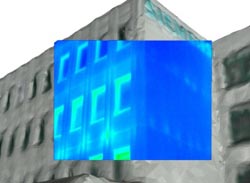Detecting Energy Losses from the Air

<br>
The technology uses an image processing system that works with aerial photographs taken by a camera drone. The system software uses the data from the cameras to create a three-dimensional model that visibly depicts thermal radiation, liquid and gas losses, areas with poor insulation, and spots with heavy moisture. The technology is already being used in the construction project for the new Aspern Urban Lakeside district in Vienna, Austria.
Searches for sources of geothermal losses (hotspots) were previously conducted on the ground, as were monitoring operations to measure progress at major construction sites. Stationary webcams or laser scanners were used here, but both have drawbacks because their viewing angle is often limited and the imaging devices can also get dirty from dust and rain. Recording equipment in a camera drone doesn't need to be cleaned and can also be used to create three-dimensional images.
The Aspern drone was built by Ascending Technologies. Depending on what it's used for, the drone can be equipped with either a conventional camera or a thermal imaging camera.
Aerial thermal inspections with the latter take less time and are also more reliable than inspections on the ground. Experts from Siemens Corporate Technology can collect all the required data during a flyover and then analyze it on a computer. This makes it possible to easily monitor objects that are normally difficult to access, and whose examination using conventional technologies would in some cases require inspectors to climb buildings.
The drone equipped with Siemens technology has been documenting the progress of construction in Aspern in test operations for a year. The new district in the eastern part of Vienna is itself a type of test lab for future urban design. The data the drone collects from above the giant construction site will help optimize planning operations in relation to logistics, energy consumption, and financing throughout the construction period. Use of the system is not limited to construction projects, as it can also assist with the efficient maintenance and servicing of finished buildings.
Media Contact
More Information:
http://www.siemens.com/innovationnewsAll latest news from the category: Power and Electrical Engineering
This topic covers issues related to energy generation, conversion, transportation and consumption and how the industry is addressing the challenge of energy efficiency in general.
innovations-report provides in-depth and informative reports and articles on subjects ranging from wind energy, fuel cell technology, solar energy, geothermal energy, petroleum, gas, nuclear engineering, alternative energy and energy efficiency to fusion, hydrogen and superconductor technologies.
Newest articles

Superradiant atoms could push the boundaries of how precisely time can be measured
Superradiant atoms can help us measure time more precisely than ever. In a new study, researchers from the University of Copenhagen present a new method for measuring the time interval,…

Ion thermoelectric conversion devices for near room temperature
The electrode sheet of the thermoelectric device consists of ionic hydrogel, which is sandwiched between the electrodes to form, and the Prussian blue on the electrode undergoes a redox reaction…

Zap Energy achieves 37-million-degree temperatures in a compact device
New publication reports record electron temperatures for a small-scale, sheared-flow-stabilized Z-pinch fusion device. In the nine decades since humans first produced fusion reactions, only a few fusion technologies have demonstrated…





















